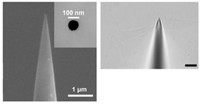Advertisement
Grab your lab coat. Let's get started
Welcome!
Welcome!
Create an account below to get 6 C&EN articles per month, receive newsletters and more - all free.
It seems this is your first time logging in online. Please enter the following information to continue.
As an ACS member you automatically get access to this site. All we need is few more details to create your reading experience.
Not you? Sign in with a different account.
Not you? Sign in with a different account.
ERROR 1
ERROR 1
ERROR 2
ERROR 2
ERROR 2
ERROR 2
ERROR 2
Password and Confirm password must match.
If you have an ACS member number, please enter it here so we can link this account to your membership. (optional)
ERROR 2
ACS values your privacy. By submitting your information, you are gaining access to C&EN and subscribing to our weekly newsletter. We use the information you provide to make your reading experience better, and we will never sell your data to third party members.
Analytical Chemistry
An Ionic Guillotine Enables Peering Inside Cells
Mass Spectrometry: A new method wears away cell surfaces, paving the way for 3D subcellular images
by Katie Cottingham
February 4, 2011

To pinpoint proteins and other chemicals within cells, researchers often tag them with fluorescent molecules. Now, researchers show that with a few tweaks, a method called secondary ion mass spectrometry (SIMS) can map out the chemicals within a cell, without disturbing the cell's biochemistry (Anal. Chem., DOI: 10.1021/ac1030607).
Scientists developed SIMS about 50 years ago and have used it to analyze solid surfaces and films. In a typical SIMS setup, researchers shoot an ion beam at a surface. The beam causes molecules and elements on the surface to pop off. A mass spectrometer then detects the ejected molecules.
To analyze what lurks under a cell's surface, research chemist Christopher Szakal, of the National Institute of Standards and Technology, and colleagues there and at the National Cancer Institute tweaked the standard SIMS protocol in two ways. First, they freeze-dried the cells, taking care not to let them burst as they froze. With the cells frozen, they next sliced them with a focused ion beam, a stream of ions more powerful than the one typically used with SIMS. The beam moved across the cell horizontally, slicing the cell parallel to the surface it rested on, like a slow-moving guillotine. After removing a fraction off the cell's top, the researchers could then image the interior of the cell following the typical SIMS protocol.
As a proof of concept, the scientists used the new technique to map out the chemicals within cells from a human cancer cell line. By mapping specific classes of biomolecules, they could produce a coarse-grain image of basic cell structures, including the membrane, the cytosol, and the nucleus. The researchers envision using this type of information to understand how a cell's biochemistry changes under different circumstances, such as disease states or life cycle stages.
Chemist Nick Winograd of Pennsylvania State University praises the paper, saying "They've made people think about different ways of doing SIMS." But Winograd worries that freeze drying the cells could alter their 3D structure. Szakal says that because their freeze drying method doesn't rupture the cells, only the cell's thickness will change as water leaves. Meanwhile, the intracellular components will remain inside the outer membrane.
Szakal and his colleagues think the method also could generate 3D subcellular images by repeating the focused ion beam step, one slice at a time. In addition, they hope to use their imaging method to compare the components of healthy and diseased cells, as well as assess the differences in cells at different growth stages.





Join the conversation
Contact the reporter
Submit a Letter to the Editor for publication
Engage with us on Twitter